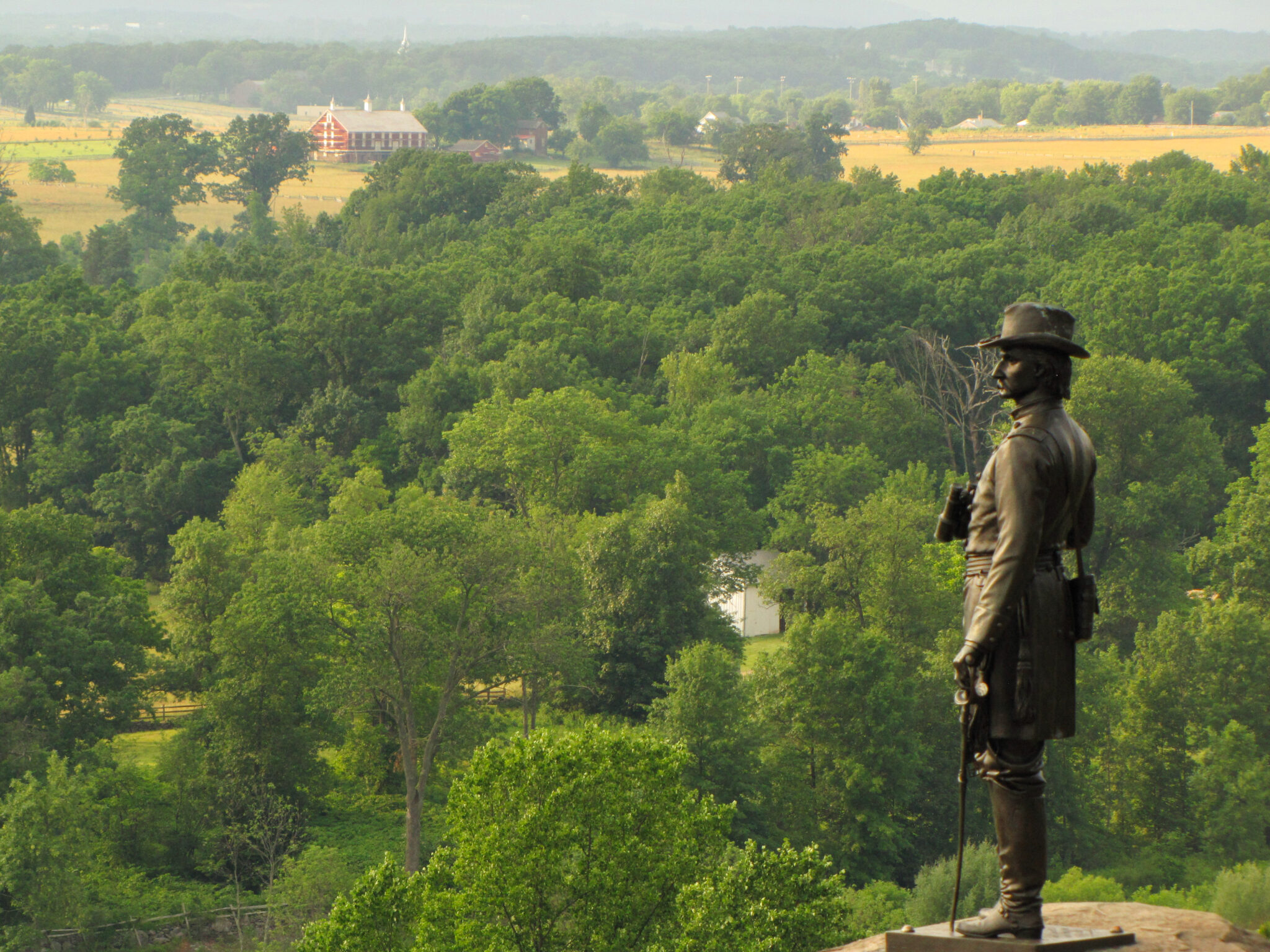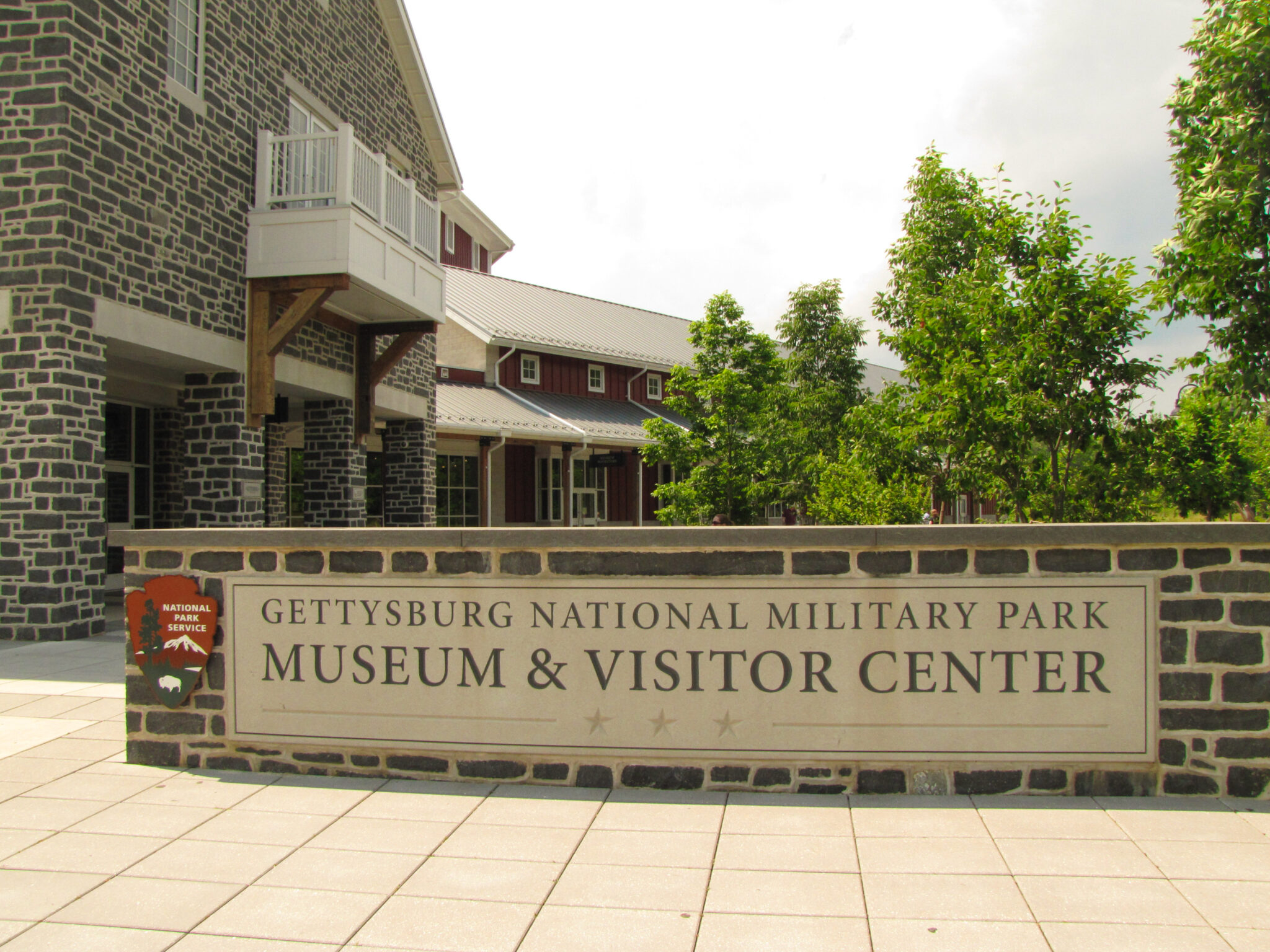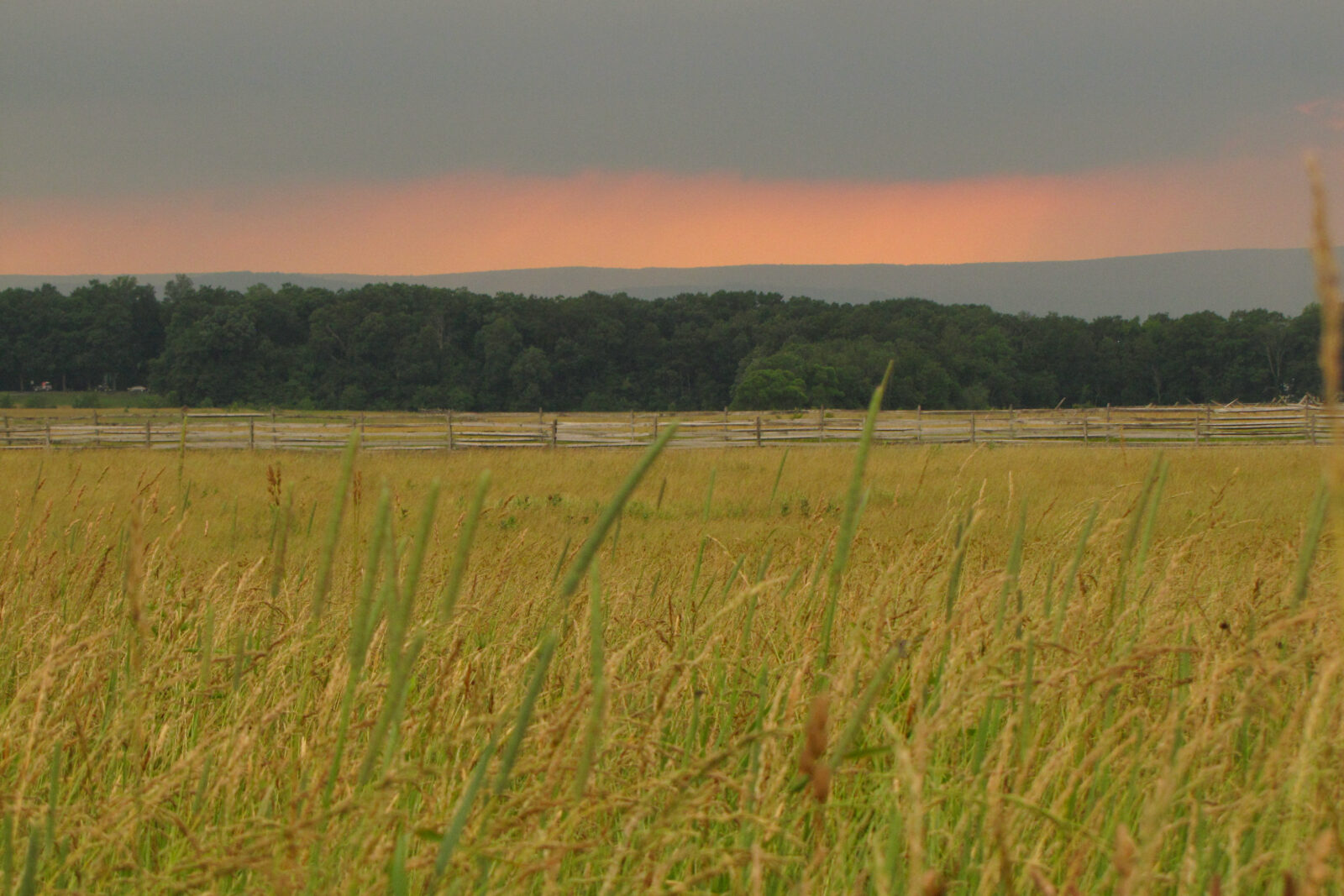This episode of Treehuggers International originally aired on Aug. 4th, 2011, on KBZT FM 94/9. Many thanks to Perry Wheeler with the NPCA, and Katie Lawhon at Gettysburg National Military Park for their help making this program possible.
Treehuggers International welcomes Cinda Waldbuesser, the Pennsylvania senior program manager with the National Parks Conservation Association (NPCA), to talk about the restoration work done at Gettysburg National Military Park over the last 10 years by the National Park Service, in conjunction with the Gettysburg Foundation.
Fought over the course of three days in July 1863, Gettysburg is the most famous of Civil War battles, and one of the most terrible, even for a war which had no shortage of carnage or butchery, with some 50,000 casualties on both sides, including 10,000 killed.
The battle was the culmination of Confederate General Robert E. Lee’s second invasion of the north, following an inconclusive invasion of Maryland the previous year, which resulted in the savage bloodletting at the Battle of Antietam, a battle whose scope and casualties shocked both sides.
Rather than an attempt to seize territory, Lee’s invasion of Pennsylvania was prompted by supply necessities. The Army of Northern Virginia could no longer forage for food or live off the land in war-torn Virginia, so following the Confederate victory at Chancellorsville in May 1863, Lee gambled on Union confusion to launch a summer invasion of the north.
While Confederate cavalry under General J.E.B. Stuart threatened Harrisburg and briefly occupied Carlisle, the bulk of Lee’s army barely penetrated the Keystone State’s border by more than 12 miles. Federal forces under the Army of the Potomac’s new commander General George Meade positioned themselves between the Confederates and Washington D.C., buying time for reserves to be drawn out of the capital to help repel the southern invasion. Federal cavalry, newly energized after a bold, undermanned stand at the Battle of Brandy Station, initiated flanking maneuvers against Stuart’s cavalry units.
Following several days of small-scale firefights, both armies jockeyed for position near the crossroads town of Gettysburg, through which the major east-west National Road and north-south Taneytown Road pass. Lee’s forces, now advancing from the north, pushed panicked Federal defenders through the streets of Gettysburg after engagements at Barlow Knoll and Oak Ridge smashed the Union line on July 1st, but Meade fell back to excellent, high ground defensive positions anchored at Cemetery Hill, forming a line running some four miles south of town.
As the lines coalesced, Confederate flanking attempts were made on July 2nd on the Federal right at Culp’s Hill, and daylong close-quarter bloodbaths took place in benign-sounding locales like the Wheatfield, which changed hands several times in a matter of hours, and at the Peach Grove, which fell to Confederate advances by the end of the day on July 2nd.
At the chillingly named Devil’s Den, at the base of Little Round Top, Federal troops held off Confederate assaults during hours of macabre hand-to-hand fighting, often in narrow gaps and draws in bizarre, otherwordly rock outcroppings.
The fighting sapped southern strength on the Union left, enabling Meade’s forces to quickly claim and hold Little Round Top. By late afternoon Union artillery was raining devastating fire onto southern forces attacking out of Pitzer Woods and Warfield Ridge to the west and south.
By the end of July 2nd, the Union line held: to the north along the edge of Gettysburg at Cemetery Hill, and to the south at Little Round Top, where the 20th Maine under Colonel Joshua Chamberlin famously held the southern end of the line, thereby maintaining Union control of the battle, but under murderous, non-stop Confederate attack by newly-committed Alabama troops.
Union defenders paid dearly at the Wheatfield and Devil’s Den, but bought time for reinforcements, which continued to arrive from Washington even as Lee was committing his reserves with a failed assault on East Cemetery Hill.
A Massed, Futile Assault
Realizing he needed to break the back of the Union line, Lee chose to do so at the center with a massive assault, which almost all of his staff, including his deputy, General James Longsteet, vehemently opposed. Union General Meade had correctly anticipated Lee’s moves throughout the battle, falling into excellent defensive positions by the end of the first day, and at a Council of War at the end of the second day predicted Lee would advance on the Union center, just over the hill beyond his headquarters near a farmhouse and several groves of trees.
After several cavalry actions on July 3rd, including a renewed assault at the northern end of the Union line near Culp’s Hill, Lee unleashed the largest artillery bombardment of the war up to that time on the Union center. Holding the high ground along Cemetery Ridge, Meade knew he held an advantage against an attack from the west, and only ordered batteries on either end of the barrage to fire on Confederate positions, leaving artillery in the center to remain largely silent during the two-hour bombardment. There was no secret as to what was coming next.
Advancing in three division-sized groups from Seminary Ridge and Spangler’s Woods along a mile-long front, Longstreet placed General George Pickett in command of the assault, which saw the bulk of nine regiments of the Army of Northern Virginia advancing uphill against fortified artillery and infantry positions.
The weather was hot and humid, in the 80s, and the objective was a grove, or copse, of trees a mile away at the center of the Federal II Corps position, but this was academic to Confederate officers. The advance was in broad daylight over a mile of open ground, with zero surprise or cover.
Union artillery began firing before the southern infantry had advanced beyond the treeline, and long rounds did damage to Confederate troops massing along Seminary Ridge. The Confederates advanced in a skirmish line at a medium pace, and largely held discipline while under withering artillery fire from the federal left and right. The center remained silent, even though the advancing southerners could clearly see Union cannon emplacements pointing directly at them.
About halfway across the field the Confederates jumped into double-time, at which point federal artillery in the center at last fired, wiping out half of the advancing troops within a matter of minutes. Federal infantry opened up on the advancing survivors as they closed in on Union lines, cutting down soldiers one and two at a time, though a few Confederate troops managed to reach the Angle near the bullet-pocked Brian farmhouse before being surrounded. One New York battery grimly summed up the point-blank use of artillery at this stage of the Confederate charge as “double canister shot at 10 yards.” It was one of the worst slaughters of the war.
The “High Water Mark” of the Confederacy
Today, the Angle and Copse of Trees mark the Confederate High Water Mark, today dotted up and down the line with Union unit monuments, facing Confederate monuments a mile away along Seminary Ridge.
The High Water Mark didn’t just represent the failure of the southern effort at Gettysburg, but the ultimate military reach of the Confederacy. Though the south would have one last major victory at Chattanooga later in 1863, the die was cast with what became known as Pickett’s Charge. The war would drag on for nearly two more years, but never again would a Confederate army manage such a large-scale offensive.
By 1864, newly-installed Union commander General Ulysses Grant initiated total war against the south, bringing to bear the full might of Union industry, technology and manpower against the southern states, and the U.S. at last found a way to grind out a winning formula, however terrible, to a war it had once taken far less seriously than its adversary, at first dismissively referring to motivated Confederate troops as simply rebels and mutineers.
A New Cyclorama Home, and a Casino Threat
Preservation of the Gettysburg battlefield began shortly after the battle ended, with a portion of East Cemetery Hill developed by the-then War Department into Gettysburg National Cemetery. Many of the near 5,000 Union troops killed in the battle were buried at this new National Cemetery, where President Abraham Lincoln delivered the Gettysburg Address during the cemetery’s dedication four months later in November 1863. The Department of the Army managed the battlefield site for decades before transferring the property to the National Park Service in 1933.
National Battlefields and Historic sites play somewhat the same role in the eastern U.S. as National Monuments do in the west; that is, protecting resources and practicing conservation within a smaller footprint, but on a scale which still enables wildlife corridors and open space aesthetics, and acts as a bulwark to encroaching urbanization.
The Battle of Gettysburg retains a place in history as a turning point in the U.S. Civil War, but its legacy extends beyond military history, as Gettysburg National Military Park preserves some 4,000 acres of the battlefield and adjoining areas, including streams, fields, meadows, orchards and several hills within the Pennsylvania Piedmont coastal plain and Potomac watershed.
Working in conjunction with the National Park Service in renovating the battlefield to its state on the eve of battle in 1863, the Gettysburg Foundation is representative of the kind of locally-based, public/private partnerships which have developed over the last decade, enabling Park Service professionals to focus on resource protection and law enforcement, while foundation volunteers and employees staff the new LEED-certified visitor center and museum.
Opened in 2008, the new Gettysburg visitor center not only features outstanding historic artifact displays and film experiences, it is also the new home of the restored Gettysburg Cyclorama, painted by French artist Paul Philippoteaux and first exhibited in a tour of the U.S. in 1883.
The NPCA has also worked with the National Park Service and Gettysburg Foundation to help remove the Gettysburg National Tower, built in 1974 on private property but considered a park eyesore by battlefield conservationists until its demolition in 2000. The NPCA has also helped combat the threat of a proposed casino in significant proximity to the battlefield’s borders.

More about this post at:
- Gettysburg National Military Park
- Gettysburg Foundation
- National Parks Conservation Association
- Casino Backers Take Gaming Control Board to Supreme Court (Harrisburg Patriot-News; 6/20/11)
- Casino Applicant Appeals (Gettysburg Times; 6/20/11)
- Tourism Funds In Jeopardy (Gettysburg Times; 4/24/11)
- Gettysburg Nixes Casino (Washington Post; 4/20/11)
- No Dice: Gaming Board Rejects Gettysburg Casino (USA Today; 4/16/11)
- Gettysburg Casino Opponents Cheer Gaming Board Decision (Harrisburg Patriot-News; 4/15/11)
- Gettysburg Battlefield Acquires 95 Historic Acres (Philadelphia Inquirer; 3/26/11)
- The Gettysburg Battlefield (CBS News; 11/7/10)
- Hundreds at Hearing Speak for, Against Proposed Gettysburg Casino (Philadelphia Inquirer; 9/2/10)
- Opponents Outnumbered In Public Battle Over Casino Proposal (Harrisburg Patriot News; 9/1/10)
- Casino Foes, Pro Testify (Gettysburg Times; 9/1/10)
- Battlelines Drawn Over Gettysburg Casino (The Telegraph; 8/29/10)
- Architecture Fans Fight to Save Gettysburg’s Cyclorama Building (USA Today; 4/5/10)
- Two Developers Have Plans for Relocated Gettysburg Cyclorama Building (York Town Square; 11/9/08)
- Cyclorama Lawsuit May Get Federal Hearing (Gettysburg Times; 6/30/08)
- Casino Considered Near Gettysburg Battlefield (ABC News; 7/3/06)

All photos © 2011 Tommy Hough, all rights reserved. Not intended for redistribution.

